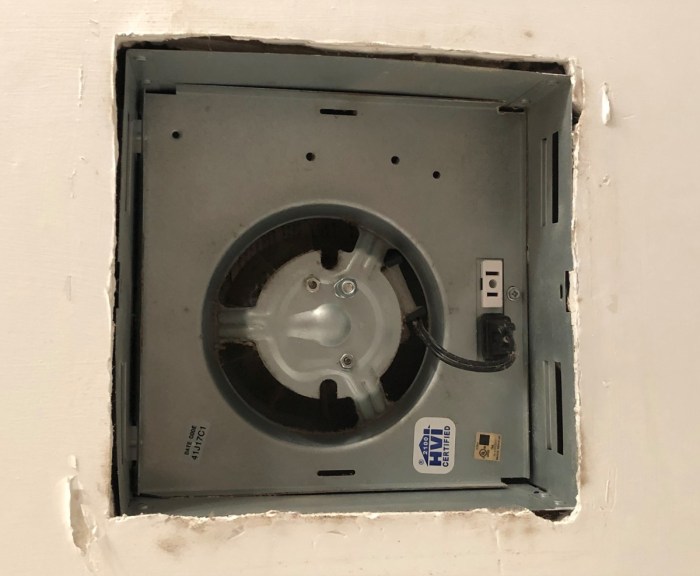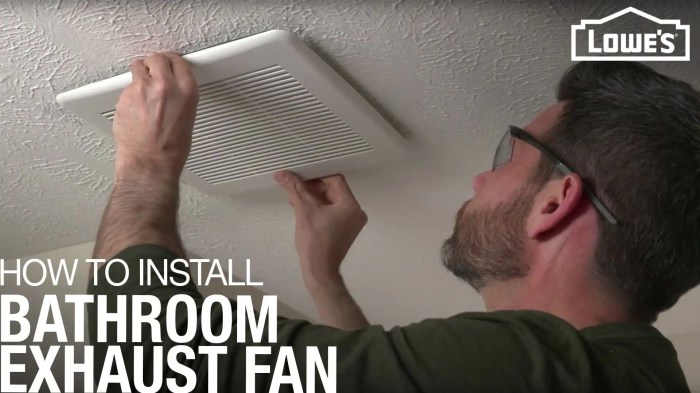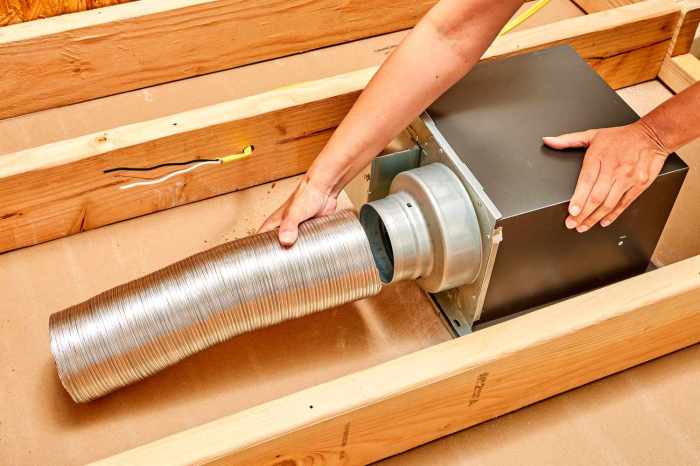The bathroom, a haven of relaxation and rejuvenation, should be a sanctuary free from the incessant hum of noisy exhaust fans. Installing a silent bathroom exhaust fan can transform your bathroom experience, providing proper ventilation without sacrificing tranquility. In this comprehensive guide, we will delve into the intricacies of selecting, installing, and troubleshooting silent bathroom exhaust fans, empowering you with the knowledge to create a peaceful and well-ventilated bathroom oasis.
Silent bathroom exhaust fans are a game-changer, eliminating the intrusive noise associated with traditional fans. These fans operate at exceptionally low decibel levels, ensuring that your bathroom remains a serene space for relaxation and privacy. Moreover, proper ventilation is crucial for maintaining a healthy bathroom environment, preventing the buildup of moisture and odors.
Understanding Silent Bathroom Exhaust Fan Installations
Silent bathroom exhaust fans are designed to minimize noise levels while effectively removing moisture and odors from bathrooms. They offer several benefits, including improved air quality, reduced humidity, and prevention of mold and mildew growth.Bathroom exhaust fans serve a crucial purpose by extracting stale air and replacing it with fresh air from outside.
Proper ventilation in bathrooms is essential for maintaining a healthy indoor environment, as it helps prevent the accumulation of moisture, which can lead to respiratory problems and other health issues.
Benefits of Silent Bathroom Exhaust Fans
* Improved air quality by removing pollutants and odors
- Reduced humidity levels, preventing condensation and mold growth
- Enhanced comfort by eliminating musty smells and providing fresh air
- Energy efficiency by reducing the need for air conditioning or heating
- Increased longevity of bathroom fixtures by preventing damage from moisture
Selecting the Right Silent Exhaust Fan
Selecting the appropriate silent exhaust fan for your bathroom is crucial for effective ventilation and noise reduction. Here are some key considerations:
Size and Type
The size of the exhaust fan depends on the size of your bathroom. A general rule of thumb is to choose a fan that can exhaust at least 50 cubic feet per minute (CFM) for every 50 square feet of floor space.There
are three main types of exhaust fans:
-
-*Ceiling-mounted
Installed in the ceiling, these fans are suitable for most bathrooms.
-*Wall-mounted
Mounted on the wall, these fans are ideal for smaller bathrooms or bathrooms with limited ceiling space.
-*Inline fans
Installed in the ductwork, these fans are often used in larger bathrooms or when noise reduction is a priority.
Features
When selecting a silent exhaust fan, consider the following features:
-
-*Noise level
Measured in sones, the noise level of an exhaust fan should be as low as possible. Aim for a fan with a noise level below 2 sones.
-*Airflow
The airflow of an exhaust fan determines how much air it can move. Choose a fan with an airflow that meets the ventilation requirements of your bathroom.
-*Energy efficiency
Look for fans with Energy Star certification, indicating energy efficiency and cost savings.
Planning the Installation
Planning the installation of a silent exhaust fan is crucial to ensure optimal performance and longevity. It involves selecting the appropriate location, determining the ductwork route, and gathering the necessary tools and materials.
Necessary Tools and Materials
- Silent exhaust fan
- Ductwork (e.g., flexible or rigid duct)
- Duct tape
- Screwdriver
- Drill
- Wire cutters
- Electrical tape
- Caulk gun
Optimal Location
The optimal location for the exhaust fan is directly above the shower or bathtub, where moisture is concentrated. Consider the following factors when choosing the location:
- Distance from the shower: The fan should be installed as close to the shower as possible to maximize its effectiveness.
- Ceiling height: The fan should be installed at least 6 feet above the floor to prevent it from interfering with showerheads or other fixtures.
- Accessibility: The fan should be easily accessible for maintenance and cleaning.
Ductwork
The ductwork should be designed to minimize noise and maximize airflow. Consider the following guidelines:
- Duct size: The duct size should be at least 4 inches in diameter to ensure adequate airflow.
- Duct length: The duct should be as short as possible to reduce noise and pressure drop.
- Duct bends: Avoid sharp bends in the ductwork, as they can create noise and impede airflow.
- Duct insulation: Insulating the ductwork can reduce noise transmission and improve fan efficiency.
Installing the Exhaust Fan
Installing a silent exhaust fan involves careful planning and precise execution. Follow these steps to ensure a successful and efficient installation:
Wiring
Connect the fan’s wires to the appropriate electrical wires in the ceiling. Typically, black wires connect to black wires, white wires to white wires, and green or bare copper wires to the ground wire.
Mounting
Mount the fan housing to the ceiling joists using screws or bolts. Ensure it is level and securely fastened. Then, insert the fan motor into the housing and secure it with the provided screws.
Connecting the Ductwork
Connect the fan’s ductwork to the ceiling vent. Use flexible ductwork if necessary to accommodate any bends or angles. Secure the ductwork with duct tape or clamps to prevent air leaks.
Overcoming Challenges
Common challenges during installation include:
- Improper Wiring: Verify all wire connections are secure and match the correct colors.
- Uneven Mounting: Use a level to ensure the fan housing is level before mounting the fan motor.
- Air Leaks: Inspect the ductwork connections and seal any gaps with duct tape or mastic sealant.
Troubleshooting Silent Exhaust Fan Installations
Even with careful planning and installation, issues may arise with silent exhaust fans. Troubleshooting these problems promptly can ensure optimal performance and prevent further complications.
Common problems include excessive noise, poor airflow, and electrical issues. Here are some troubleshooting tips:
Noise
- Loose fan blades: Ensure the fan blades are securely attached to the motor shaft. Tighten any loose screws or bolts.
- Improperly installed fan housing: Check that the fan housing is properly aligned and sealed to prevent vibrations and noise.
- Ductwork issues: Ensure the ductwork is free of obstructions and not too narrow or long, as this can create excessive airflow resistance and noise.
Poor Airflow
- Blocked ductwork: Inspect the ductwork for any obstructions, such as lint or debris, that may restrict airflow.
- Undersized ductwork: Ensure the ductwork is of an appropriate size for the fan’s airflow capacity. Undersized ductwork can restrict airflow and reduce fan efficiency.
- Exhaust vent not opening: Check if the exhaust vent outside is opening properly. A blocked or stuck vent can prevent air from being exhausted.
Electrical Problems
- Loose wiring: Ensure all electrical connections are tight and secure. Loose wiring can cause intermittent operation or electrical shorts.
- Faulty motor: If the fan motor is not operating properly, it may need to be replaced.
- Tripped circuit breaker: If the exhaust fan is not turning on, check if the circuit breaker has tripped and reset it if necessary.
Preventive Measures
To avoid potential issues with silent exhaust fan installations, consider the following preventive measures:
- Regular cleaning: Clean the fan blades, housing, and ductwork regularly to prevent dust and debris buildup.
- Inspect ductwork: Regularly inspect the ductwork for any damage or obstructions.
- Use high-quality materials: Choose exhaust fans and ductwork made of durable materials to ensure longevity and performance.
Final Thoughts
Installing a silent bathroom exhaust fan is a rewarding endeavor that can significantly enhance your bathroom experience. By following the steps Artikeld in this guide, you can ensure a quiet and well-ventilated bathroom that meets your specific needs. Remember to carefully consider the size, type, and features of the exhaust fan, plan the installation meticulously, and troubleshoot any issues promptly.
With a silent bathroom exhaust fan, you can finally enjoy a tranquil and refreshing bathroom environment.



